Indications for limb amputation. Features of the operation and rehabilitation
Amputation of limbs is considered one of the oldest operations in the history of medicine. The first descriptions date back to the 4th century BC.e. However, the inability to stop severe bleeding, as well as the lack of knowledge about the ligation of blood vessels, usually led to fatal outcomes. Doctors were advised to truncate the limb within the affected tissues, this eliminated the deadly bleeding, but did not stop the spread of gangrene.
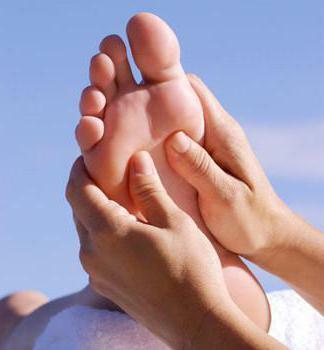 In the first century AD, Celsus Aulus Cornelius proposed a revolutionary approach for conducting such operations, including recommendations:
In the first century AD, Celsus Aulus Cornelius proposed a revolutionary approach for conducting such operations, including recommendations:
- to carry out a truncation in the level of viable tissues;
- Isolated dressing of stump vessels to prevent bleeding;
- cutting out a reserve cloth for covering the stump without pathological tension.
An important role in the improvement of limb amputation methods was played by the introduction of the method of bloodless surgery when Esmarch created the rubber tourniquet used so far.
In the modern world, among the indications for amputation, the leading positions are diabetes and cardiovascular pathologies.
Amputation is a truncation of the limb, or rather of its distal part, over the bone, but it would be a terrible mistake to treat it as a simple removal of the affected segment. This term implies plastic and reconstructive operations aimed at further rapid and effective rehabilitation of the patient.
There are certain indications for a surgical operation of this kind. Let's consider these indications in more detail.
Indications for limb amputation
- Gangrene.
- Presence of a hotbed of a serious infection that threatens the patient's life( anaerobic infection).
- Irreversible ischemia with muscular contracture.
- Long-term compression syndrome.
- Traumatic crushing of the limb with damage to the main vessels and nerves, a so-called traumatic amputation is performed.
- Obliterating vascular diseases with outcome in gangrene.
- Hemostatic tourniquet, applied more than three hours.
- Common, non-treatable neurotrophic ulcers.
- Osteomyelitis with the threat of injury to internal organs.
- A common tuberculosis lesion of bone tissue in old age.
- Malignant tumors of bones without the possibility of isolated removal of the focus.
Determination of the level of resection
 The choice of the level of amputation of the extremities depends on the degree of violation of blood supply in the operated zone, the presence of gangrene, trophic disorders, the condition of adjacent tissues and the severity of the infectious process and pain syndrome.
The choice of the level of amputation of the extremities depends on the degree of violation of blood supply in the operated zone, the presence of gangrene, trophic disorders, the condition of adjacent tissues and the severity of the infectious process and pain syndrome.
Children try to use exarticulation( articulation of the affected part at the joint level), which does not violate the further growth of the bone.
For the urgency of surgical intervention, I single out the amputation of the limbs :
is an emergency amputation performed during the first surgical intervention to remove nonviable, damaged tissues;
- urgent operation with truncation of the focus of intoxication with ineffectiveness of conservative methods of treatment;
- planned amputation performed with malignant bone damage, osteomyelitis.
- reamputation for the purpose of correction of an inconsistent stump.
Allocate a circular, ellipsoidal and patchwork amputation. Let's consider these types below.
Circular amputations
The main indications for amputation, namely guillotine( one-stage circular) amputation, are gas gangrene and resection of limbs hanging on the cutaneous muscle scrap. This intervention is carried out exclusively for emergency life indications. A significant disadvantage of this technique is the creation of a dysfunctional stump and mandatory subsequent re-imputation in order to adapt the limb to the further establishment of the prosthesis.
The advantage of this amputation is the absence of necrotic changes in the shred even with reduced blood supply.
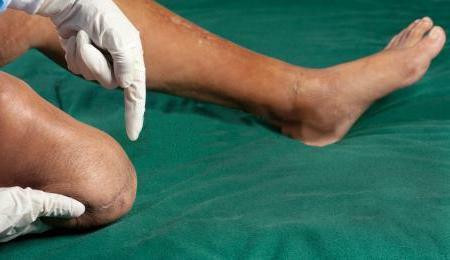 With guillotine amputation, the bone is cut off at the same level as the soft tissue.
With guillotine amputation, the bone is cut off at the same level as the soft tissue.
How is the operation performed? Amputation in the first stage consists of incision of the skin, subcutaneous fat and fascia. The edge of the displaced skin is a further reference point along this edge. At the second stage, the muscles are cut to the bone and further bone is cut. The bone end is covered by the skin and fascia.
This species is recommended on limb sections with a relatively small muscle mass.
For departments with a large muscle mass, a three-stage amputation is recommended( a simple and cone-circular amputation according to Pirogov).
The first two stages of the operation are analogous to a two-stage amputation. Further, after shearing muscles and surface tissues in the proximal direction, the muscles are re-dissected along the edge of the stretched skin. Due to this, deep muscular layers are dissected, which contributes to the further formation of a conical stump.
Patchwork methods divide:
- into single-sculled( the length of one flap equals the diameter of the stump);
- bilobate( two shreds of different sizes along the sum of the lengths that make up the diameter of the amputated limb).
When forming the stump, it must be taken into account that the scar should not be on the working surface. Scraps should be formed taking into account the ability to bear loads.
Cosnoplasty amputations
How is lower limb amputation performed? A distinctive feature is the presence of a fragment of bone, covered with a periosteum as part of a scrap.
The method of osteoplastic amputation of the leg according to Pirogov has received worldwide recognition in connection with the highly successful anatomical rehabilitation of the terminal support of the operated leg.
Advantages of the method:
- Less pronounced soreness of the stump.
- The presence of the end support of the stump.
- Preservation of proprioceptive sensitivity of muscles and tendons.
Stages of operation
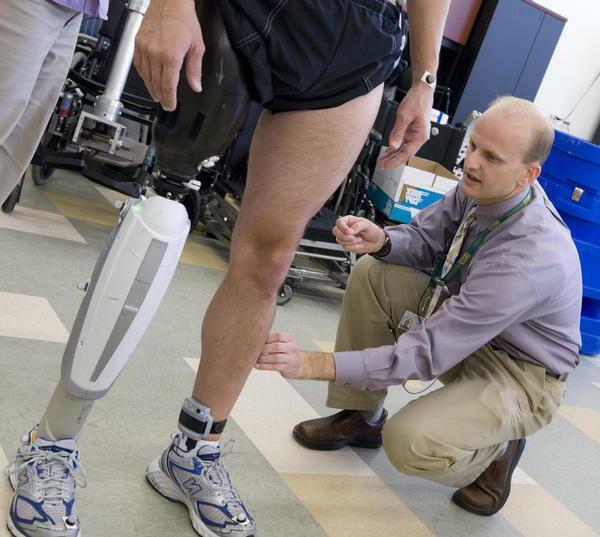 Two cuts are performed when removing the tibia along Pirogov. For this, an amputation knife is used. Initially, a cross section of soft tissues is made, exposing the ankle joint, and then performing an arcuate incision passing along the back surface of the foot. After the intersection of the lateral ligaments, the articulation of the talus bone is made, cutting off the bones of the shin. The cross section is covered with a scrap. Form the stump.
Two cuts are performed when removing the tibia along Pirogov. For this, an amputation knife is used. Initially, a cross section of soft tissues is made, exposing the ankle joint, and then performing an arcuate incision passing along the back surface of the foot. After the intersection of the lateral ligaments, the articulation of the talus bone is made, cutting off the bones of the shin. The cross section is covered with a scrap. Form the stump.
Sharp Operation
There is another method by which amputation of the lower limbs is performed.
When the foot is removed, dissection of soft tissues is carried out a few centimeters distal to the first phalanx of metatarsal bones. After otpreparovyvaniya periosteum is performed sawing the metatarsal bones and smoothing the cutter ends with a cut. The saw is covered with a plantar shred.
Consider the main causes of amputation.
Diabetic microangiopathy
The actions of the surgeon depend on the extent of the lesion. According to the prevalence of purulent necrotic lesions, five stages are distinguished:
- Surface focus of necrosis without tendon damage.
- Gangrene finger with the involvement of the first phalanx and tendons.
- Common gangrene of the fingers, combined with gangrene of the foot.
- Gangrenous lesion of the entire foot.
- Involvement in the process of the shin.
When a patient with purulent-necrotic ischemia arrives, an emergency sanation of the focus is carried out, consisting in dissection of abscesses, drainage of phlegmon, minimal resection of the affected part of bone and removal of dead tissue. After excision of nonviable tissues, operations to restore adequate blood flow to the injured limb are recommended.
In ischemia:
- the first degree only the sanation of the focus is performed;
- the second degree implies amputation of the affected finger with excision of the tendons involved in the process;
- at the third degree, amputation is performed on Sharp, a special amputation knife is used;
- treatment of the fourth degree consists in resection at the level of the shin;
- at the fifth degree the amputation is performed according to the level of the thigh.
Frostbite of the fingers and other parts of the body
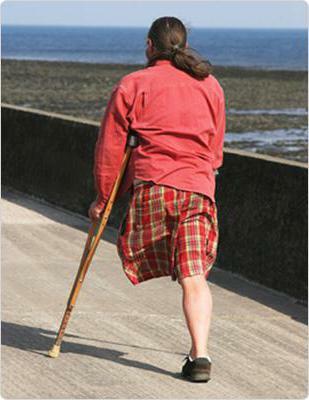 Distinguished:
Distinguished:
- total freezing( pathological changes in organs and tissues that develop as a result of circulatory disturbances and further cerebral ischemia due to prolonged exposure to low temperatures);
- fever( manifests as a chronic inflammatory reaction of the skin in the form of bluish-bordeid flaky spots with severe itching.)
Four degrees are distinguished:
The first degree is accompanied by reversible changes in the skin: hyperemia, swelling, itching, pain and unexpressed sensitivity.days the affected areas are cleared
For the second degree, the appearance of blisters with light contents, a pronounced decrease in sensitivity, possibly attachmentinfection as a result of trophic disorders
The third degree is manifested by necrotic changes in soft tissues as a result of their death, a line of demarcation is formed( delimitation of dead tissues from a healthy strip of granulations), damaged limb sites are mummified, with the attachment of microbial flora, the development of moist gangrene is possible
At the fourth degreenecrosis of the tissues spreads to the bone, the liquid in the blisters on the skin becomes cloudy black, the skin is cyanotic, the painful sensation completely disappearsThe affected limb becomes black and mummified.
Treatment
- 1st degree. Warming the patient, UHF therapy, darsonval, frost-bitten limb is ground with boric alcohol.
- 2nd degree. Processing bubbles. After their opening, the damaged skin is removed, the wound is applied with an alcohol bandage. Recommended systemic antibiotic therapy.
- 3rd degree. Bubbles are removed, necrotic tissue is excised, a dressing is applied with hypertonic saline solution. Antibiotics are used to prevent secondary infection.
- 4th degree. Necrectomy( removal of non-viable tissues) is carried out 1 cm above the necrosis line. Amputation is performed after the formation of a dry scab.
Gangrene
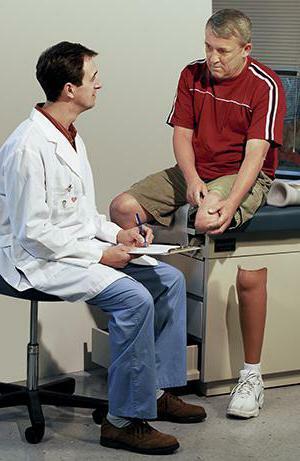 Dry gangrene is a consequence of slowly progressing infringement of blood supply of tissues, it is characteristic for patients with atherosclerosis and obliterating endarteritis.
Dry gangrene is a consequence of slowly progressing infringement of blood supply of tissues, it is characteristic for patients with atherosclerosis and obliterating endarteritis.
is distinguished by the absence of general intoxication of the body, the presence of a clear demarcation shaft. In the treatment of possible use of expectant management.
Apply: drugs that improve trophism of tissues, systemic antibacterial therapy. The operation is carried out after the formation of a clear demarcation line.
Wet gangrene occurs as a result of acute cessation of circulation( frostbite of fingers, thrombosis, compression of blood vessels).It is characterized by severe intoxication, the absence of a demarcation line and pronounced edema. Amputation with gangrene is carried out urgently, waiting for tactics is unacceptable. After detoxification therapy, surgery is performed. The amputation line should be significantly higher than the gangrene( for amputation it is recommended to perform amputation at the hip level).
Gas gangrene is an absolute indication for guillotine amputation. Characteristic manifestations: pronounced, rapidly progressive edema, the presence of gas in tissues and muscles, necrosis and phlegmon with melting of soft tissues. Visually, the muscles are grayish, dull, easily wrinkled when palpated. Skin covers are purple-cyanotic, with crushing and crunching sounds. The patient complains of unbearable, burgeoning pain.
Criteria for the consistency of the stump and its readiness for further prosthetics
For full functioning of the prosthesis, the length from the stump to the joint should be greater than its diameter. Also its physiological form( slightly narrowing downwards) and painlessness is important. The mobility of the retained joints and skin scar is assessed( its mobility and lack of adhesion to the bone base).
Signs of the vicious stump
- Spreading of the scar on the working surface.
- Excess of soft tissues.
- No cone-shaped stump narrowing.
- Melting of the rumen with tissues, its immobility.
- Too high muscle position.
- Excessive skin tension with bone filings.
- Deflection of bone segments during amputation of paired bones.
- Excessively conical form of stump.
Disability registration
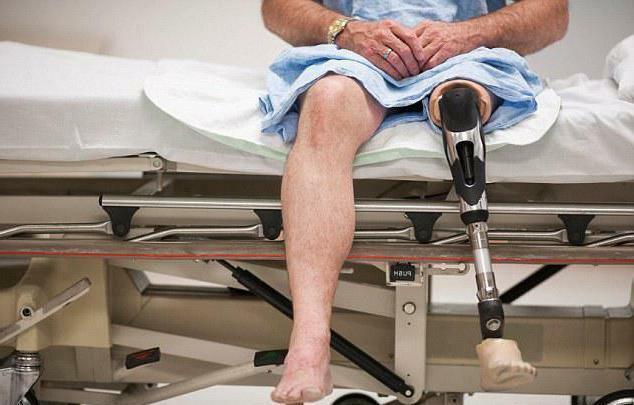 Amputation of the limb is an anatomical defect, due to which the disability group is awarded indefinitely. If an amputation occurs, the disability group is assigned immediately.
Amputation of the limb is an anatomical defect, due to which the disability group is awarded indefinitely. If an amputation occurs, the disability group is assigned immediately.
Assessment of the degree of loss of functional activity, disability and limited life, as well as the further appropriation of disability is performed by a medical and rehabilitation expert commission.
When establishing a disability group, the following is assessed:
- Ability to self-service.
- Possibility of independent movement.
- Adequacy of orientation in space and time under condition of absence of pathology of mental activity( hearing and vision are assessed).
- Communicative functions, the ability to gesticulate, write, read, etc.
- The level of control of one's own behavior( compliance with the legal, moral and ethical norms of society).
- Learning, the ability to learn new skills, mastering other professions.
- Ability to work.
- Ability to continue to work in the framework of their professional activities after rehabilitation and when creating special conditions.
- Functionality and degree of prosthesis development.
First group
Indications for the assignment of the first group:
- Amputation of both legs at the hip level.
- Absence of four fingers( including the first phalanx) on both hands.
- Amputation of the hands.
The second group
- Amputation of three fingers( with the first phalanxes) of both hands.
- Remove 1 and 2 fingers.
- Absence of 4 fingers with preservation of the first phalanges.
- Amputation of fingers on one hand with a high stump of the second hand.
- Operation of Chopar and Pirogov.
- High resections of one leg, combined with the lack of fingers of one hand or eye.
- Amputation of one hand and eye.
- Exarticulation of the hip or shoulder.
Third group
- Unilateral amputation of fingers without removal of the first phalanx.
- Double-sided finger amputation.
- High amputation of one leg or arm.
- Removal of both feet by Sharpe.
- Difference in leg lengths greater than 10 cm.
Rehabilitation after amputation
In addition to an anatomical defect, amputation of the limb leads to severe psychological trauma to the patient. The patient closes on the thoughts of his own inferiority in the eyes of society, believes that his life is over.
The success of further prosthetics is determined not only by the timeliness of the operation, the level of amputation and the further proper care of the stump.
On the 3-4th day after amputation, the prevention of flexion contractures begins, the movement of the stumps. After the removal of the joints, active training of the stump muscles is recommended. A month later, try to try on the first prosthesis.
The most important goal of rehabilitation measures is the stabilization of the patient's psychological state and the formation of an adequate relation to prosthetics.
Further activities include:
- training in the use of a prosthesis;
- a set of training to activate the prosthesis and its inclusion in the general motor stereotype;
- the normalization of coordination of movements, the use of therapeutic prostheses.
- social and rehabilitation measures, adaptation of the patient to life with a prosthesis;
- development of an individual rehabilitation program, retraining and further employment( for the 2nd and 3rd groups).
In the event of phantom pains in the amputated limb, a novocaine blockade, hypnosis sessions and psychotherapy are recommended. In the absence of improvement, surgical intervention with resection of the affected nerve is possible.
